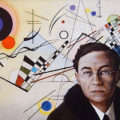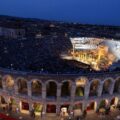“The present fascinates and interests me more than the past. I record it and enjoy it, often in solitude.”
Cesare De Michelis
Veneto has become the cradle of culture and art, discoveries and historical evidence collected over the millennia. This is how our region has become one of the most popular destinations in the world.
The first finds date back to prehistoric times, coming from settlements first by the Euganeans and then by the Paleovenetians; the situlae art, this is the peculiarity of the Veneto, that is, the working of bronze sheets modelled and joined together to form situlae, but also vases, lids and sheaths. Important evidence of this historical period can be found in the Archaeological Museum of Este.
Then came the Augustan era, the empire that Romanized the whole Italy, bringing roads, tombs and architecture with imperial beauty and majesty. The most obvious example is Verona, with its magnificent amphitheater that we can still enjoy nowadays.
The Serenissima, with the Venetian Renaissance, brought us artists such as the Bellini family, Andrea Mantegna, Giorgione, Tiziano Vecellio, Tintoretto and Paolo Veronese. In the 18th century, Venice was the most important cultural and artistic center and we remember Pittoni, Tiepolo and Canaletto; towards the end of the century, the sculptor Antonio Canova and again Andrea Palladio, without forgetting the theatre of Carlo Goldoni. Churches, bridges, bell towers and palaces… Venice redesigns itself and carries high an architecture that we can admire until our days.
Artists passing through the history, over the millennia, bring us frescoes, basilicas, villas, churches, sculptures, squares and villages.
The Veneto is therefore a Region to be discovered and since always dedicated to tourism (Abano Terme itself was already involved in hospitality at the time of the Ancient Romans, ed). Verona is also ready to host the World Tourism Event 2022: World Tourism Exhibition for Unesco sites to be held from the 15th to the 17th of September.
Unesco is an organization whose main objective is to recognize and protect the world’s cultural artistic and natural treasures. In the Veneto region, there are as many as 9 sites on the World Heritage List.
- Venezia and its Lagoon, only 50 kilometers from the AbanoRitz, a unique city in the world, was listed as a World Heritage Site in 1997. An example of reciprocity between man and natural environment in a lagoon made by extraordinary little islands.
- Vicenza and the palladian villas, just 45 kilometers from the AbanoRitz, have influenced the architecture for the centuries to come with the works of Andrea Palladio, a Renaissance architect who left his mark with elegant, balanced and harmonious buildings.
- Verona, about 90 kilometers from the AbanoRitz, was included in the World Heritage List in 2000 with its 2000 years of artistic heritage from the Ancient Rome to the Renaissance. In Italy, Verona is the second city, after Rome, for the presence of well-preserved Roman ruins such as the Arena, the Roman Theatre, the Pietra bridge, the Gavi arch, just to name but a few of.
- Padova with its 14th century frescoes, just 12 kilometers from the AbanoRitz, proclaimed Urbs Picta in 2021. Eight monuments in the historic center with pictorial cycles that tell the story of the “painted” Padova of the 14th century. Cappella degli Scrovegni, Saint Filippo and Giacomo Eremitani church, Palazzo della Ragione, the Baptistery of the Cathedral, the Chapel of the Reggia Carrarese, the Basilica del Santo and its convent, the Oratory of Saint Giorgio, the Oratory of Saint Michele: unique places that reveal works by Giotto, Guariento, Giusto de’ Menabuoi, Altichiero da Zevio, Jacopo Avanzi and Jacopo da Verona.
- The Botanical Garden of Padova, also about 12 kilometers from the AbanoRitz, was founded in 1545 and it is therefore the oldest university botanical garden in the world. Created for the study of medicinal plants, today it contains 3.500 different plant species from all over the world, thus playing a prominent role in understanding the relationship between nature and culture over the centuries.
- The Prosecco hills in the city of Treviso, about 65 kilometers from the AbanoRitz, have been included in the 2019 World Cultural Heritage list. A unique landscape stretching over 181 square kilometers of vineyards and villages along the Piave river.
- The Venetian defense works, about 100 kilometers from the AbanoRitz, included among the World Heritage Sites in 2011 with strategically fortified cities defending the Serenissima between Italy, Croatia and Montenegro. In Veneto we have the coast of Garda Lake riches of beautifully preserved walls.
- Pile-dwelling sites, the nearest is about 17 kilometers from the AbanoRitz, are a complex of 111 settlements spread across Italy, Switzerland, France, Germany, Austria and Slovenia. Verona, with the provinces of Peschiera and Tombola, is one of the sites involved, while nearby, in our beloved Euganean Hills, we find the small lake of the Costa in Arquà Petrarca.
- The Dolomites, 140 kilometers from the AbanoRitz, have been a Natural World Heritage Site since 2009, with spectacular landscapes, of worldwide significance, made up of spires, pinnacles and rock faces, karst systems, glacial morphologies and precious fossil deposits. In Veneto, the city of Belluno boasts most of these wonders.
The AbanoRitz thus becomes a strategic point for discovering the Unesco sites in Veneto, off the beaten tourist track. Choosing AbanoRitz, you also decide to protect our own Human Heritage, that is the Well-Being and the Health of body and mind: thermæ in the morning and beauty of the area the rest of the day, starting from Padova and from our Euganean Hills, candidates MAB-Unesco.











